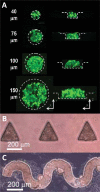Bioinspired materials for controlling stem cell fate
- PMID: 20043634
- PMCID: PMC2840210
- DOI: 10.1021/ar900226q
Bioinspired materials for controlling stem cell fate
Abstract
Although researchers currently have limited ability to mimic the natural stem cell microenvironment, recent work at the interface of stem biology and biomaterials science has demonstrated that control over stem cell behavior with artificial microenvironments is quite advanced. Embryonic and adult stem cells are potentially useful platforms for tissue regeneration, cell-based therapeutics, and disease-in-a-dish models for drug screening. The major challenge in this field is to reliably control stem cell behavior outside the body. Common biological control schemes often ignore physicochemical parameters that materials scientists and engineers commonly manipulate, such as substrate topography and mechanical and rheological properties. However, with appropriate attention to these parameters, researchers have designed novel synthetic microenvironments to control stem cell behavior in rather unnatural ways. In this Account, we review synthetic microenvironments that aim to overcome the limitations of natural niches rather than to mimic them. A biomimetic stem cell control strategy is often limited by an incomplete understanding of the complex signaling pathways that drive stem cell behavior from early embryogenesis to late adulthood. The stem cell extracellular environment presents a miscellany of competing biological signals that keep the cell in a state of unstable equilibrium. Using synthetic polymers, researchers have designed synthetic microenvironments with an uncluttered array of cell signals, both specific and nonspecific, that are motivated by rather than modeled after biology. These have proven useful in maintaining cell potency, studying asymmetric cell division, and controlling cellular differentiation. We discuss recent research that highlights important biomaterials properties for controlling stem cell behavior, as well as advanced processes for selecting those materials, such as combinatorial and high-throughput screening. Much of this work has utilized micro- and nanoscale fabrication tools for controlling material properties and generating diversity in both two and three dimensions. Because of their ease of synthesis and similarity to biological soft matter, hydrogels have become a biomaterial of choice for generating 3D microenvironments. In presenting these efforts within the framework of synthetic biology, we anticipate that future researchers may exploit synthetic polymers to create microenvironments that control stem cell behavior in clinically relevant ways.
Figures








References
-
- Odorico JS, Kaufman DS, Thomson JA. Multilineage differentiation from human embryonic stem cell lines. Stem Cells. 2001;19:193–204. - PubMed
-
- Pittenger MF, Mackay AM, Beck SC, Jaiswal RK, Douglas R, Mosca JD, Moorman MA, Simonetti DW, Craig S, Marshak DR. Multilineage potential of adult human mesenchymal stem cells. Science. 1999;284:143–147. - PubMed
-
- Scadden DT. The stem-cell niche as an entity of action. Nature. 2006;441:1075–1079. - PubMed
-
- National Research Council (U.S.) Inspired by biology : from molecules to materials to machines. National Academies Press; Washington, D.C.: 2008. Committee on Biomolecular Materials and Processes. - PubMed
Publication types
MeSH terms
Substances
Grants and funding
LinkOut - more resources
Full Text Sources
Other Literature Sources
Medical

